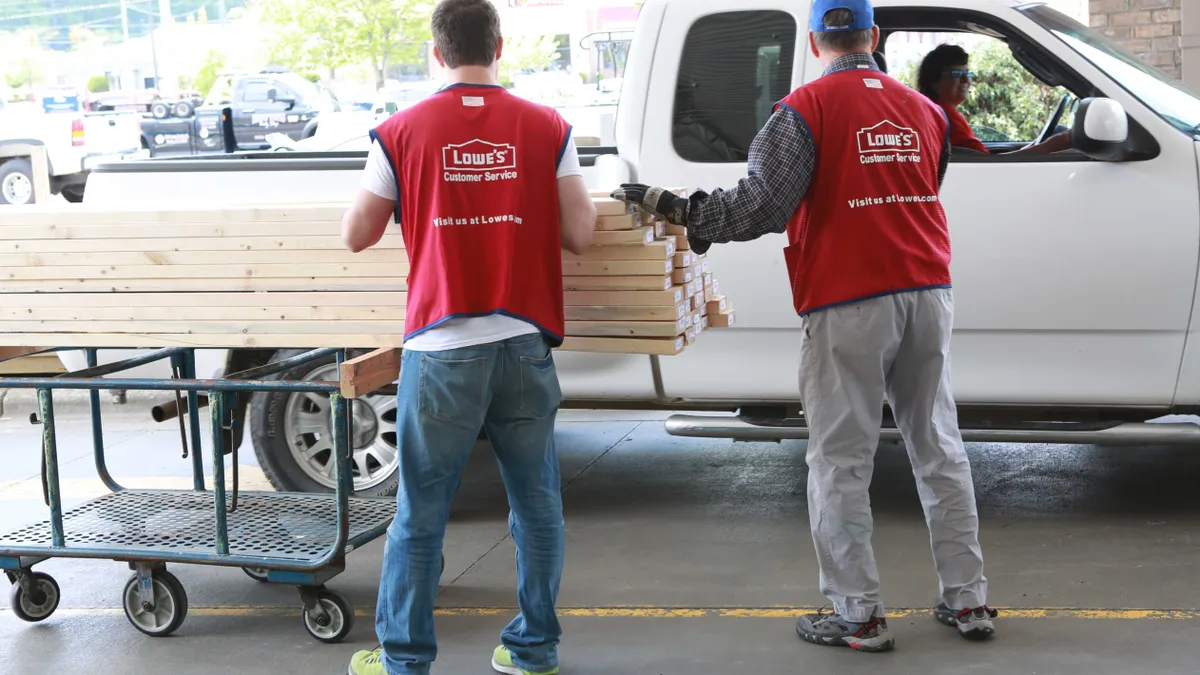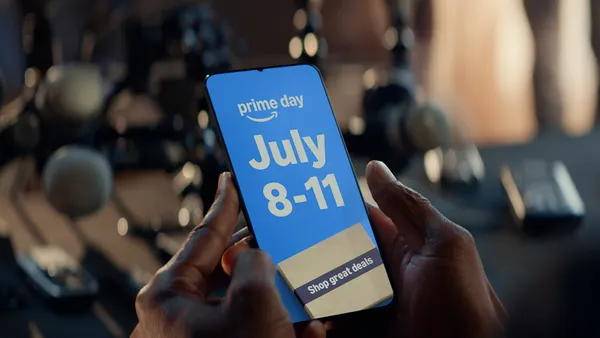Ask someone what the most popular products sold in 2020 were and they may answer toilet paper, face coverings and hand sanitizer.
But among the top sellers was a group of products even more unexpected: Faucets, kitchen cabinets and toilets were the most popular products sold in 2020, according to data from the NPD Group.
While the connection between a pandemic and most of the popular items sold at mass merchants was obvious, it wasn't as immediately clear why demand in the home improvement sector skyrocketed. According to NPD, dollar sales in the category rose 22% in 2020.
But as life changed seemingly overnight, consumers began to invest into the spaces they started spending most of their time in.
A category on the rise
Growth in the home improvement sector has picked up in recent years, coinciding with the rising homeownership rate.
In 2010, the first full year following the Great Recession, the homeownership rate dropped to 65.4%. And in 2015, it dropped to 63%, representing a 4.2 percentage point decline from 2007, according to data from the American Community Survey.
The rate, however, has steadily inched its way back up and in 2019 was 64.1%.
This, coupled with the fact that several generations were entering new phases of their lives that required home improvement projects — millennials moving into their first homes and empty nesters looking to renovate childhood bedrooms — created an opportunity for growth in the sector.
As some consumers opted to move into existing homes rather than new construction, upgrading appliances was "low hanging fruit" in terms of renovations and upgrades they could undertake on their own, according to Chad Lyons, head of Wells Fargo's electronics and appliances business.
The rise of higher-end, smart appliances, especially in the kitchen, helped propel the sector's growth further in recent years.
"It became a little bit of an aspirational purchase versus, 'I need to make sure I've got something that's really functional for my family,' so to speak," Lyons said. "There were some trends in terms of the investment."
How the pandemic altered consumers' view of home
In March 2020, when the pandemic took hold, nearly every aspect of the retail industry was upended.
Many nonessential retailers were forced to temporarily shutter their storefronts and quickly shift operations online. Essential retailers, like mass merchants, on the other hand, were faced with problems of their own, like dealing with supply chain and inventory problems as items began to fly off the shelves.
Most home improvement retailers were also classified as essential, therefore allowed to remain open. They weren't hit with the immediate influx of demand from panic buying, but as consumers came to realize spending more time at home wouldn't be as temporary as initially thought, categorical demand began to rise.
"After the first couple months, there was definitely an appetite to invest in one's home because you're stuck there," said Timothy Derr, a partner in the consumer practice of Kearney. "We saw it across home improvement, home furnishings as well. We started to think about updating spaces that we might not have spent so much time in before. You've seen it everywhere from the home office to the kitchen to the bathroom, even into the backyard."
In fact, 77.2% of people in 2020 took on at least one home improvement project — everything from light gardening to full-scale remodels — according to GlobalData. This was up from 68.2% of consumers undertaking one in 2019.
The surge in demand was evidenced in The Home Depot and Lowe's earnings figures for the year. For fiscal 2020, Home Depot reported net sales increased nearly 20% to $132.1 billion, while total comps rose 19.7% and U.S. comps increased 20.6%. Net income increased 14.4% to $12.9 billion. Meanwhile, at Lowe's, full-year net sales shot up 24.2% to $89.6 billion, while U.S. comps rose 26.8%. Net earnings increased 36.3% to $5.8 billion. Smaller rival Ace Hardware reported net sales increased 27.9% to $7.8 billion, while net income jumped 125.7% to $316.9 million.
"People were not able to go to restaurants, people were not able to go to Europe or travel anywhere. ... What better way to spend your hours, especially in a weekend, than doing things in the yard, being out in the fresh air?"

Mike Horak
Commercial Leader in Wells Fargo's outdoor products group
As many employers sent their staff home to work and schools implemented virtual learning, consumers started to spend a lot more time in their personal spaces. This, in many cases, meant appliances were being used more than ever and getting worn out faster.
"There was just an increase in the consumer replacement cycle," Lyons said. Appliances "ended up being upgraded and being invested in."
Working from home also cut out, sometimes hours, of commuting time every day, giving consumers time back to participate in recreational activities.
"There's a little bit extra time in the day to do things, so people became very intrigued about doing that themselves," Mike Horak, commercial leader in Wells Fargo’s outdoor products group, said. This included mowing the lawn or landscaping, activities that may have otherwise been outsourced to professionals. "It was that homeowner that wanted to take care of their yard. For years, they had never had the time or the opportunity to do it. Work and stay-at-home allowed people to get out in the yard and take care of their property. That was the biggest phenomenon we saw."
But for some consumers, they not only had extra time on their hands, but extra cash as well from not being able to take vacations. The government relief also helped propel spending in the category. For the latest round of stimulus, the average consumer spent 21% of their check on an item related to the home, and in the round prior to that, eligible consumers spent 28% of their check in that category, according to GlobalData.
The outside of the home also received increased attention from consumers because the outdoors were deemed as one of the few safer places to gather in small groups. The growth in these areas of home improvement, including patios and gardens, over the past year has been "off the chart," according to Horak.
"People were not able to go to restaurants, people were not able to go to Europe or travel anywhere. People were reticent to do that," Horak told Retail Dive. "What better way to spend your hours, especially in a weekend, than doing things in the yard, being out in the fresh air? Because you really couldn't go anywhere."
Living in or near large cities also became less critical, spurring a migration of many consumers to the suburbs and beyond to give themselves more space.
Housing demand has been heightened this past year as evidenced by prices increasing roughly 18% across the board. And according to Statista, the homeownership rate in the U.S. last year reached 65.8%, the highest it's been since 2010 when it was 66.5%.
To the benefit of home improvement retailers, buying a home oftentimes comes with additional related costs. "Whether it's buying a new washer and dryer. Or a previous homeowner never did anything with their yard, but I'm going to buy a handheld trimmer. I'm going to buy a power washer. I'm going to buy a lot more," Horak said.
Winning over pros
Despite the rapid rise in do-it-yourself customers this past year, the pro segment also experienced growth and "is going to continue to be an important facet of the market," Derr said.
While there was a slight pause in professional activity at the start of the pandemic as consumers were initially wary of having individuals enter their households, demand has ticked back up.
Among home improvement retailers, Home Depot has historically been the preferred destination for pro customers. But Lowe's has been taking steps more recently to capture share among this cohort.
In June, the retailer rolled out "Lowe's for Pros JobSIGHT," which is an augmented video chat tool. It allows professionals to virtually connect with clients and businesses. Lowe's said the technology was the first initiative it rolled out to help its pro customer base connect with consumers, and it promised to invest more into this segment of its business. This past April the retailer went deeper to capture what it estimates is a nearly $400 billion pro product market by introducing a tailored shopping experience designed specifically for this audience. New in-store features include The Pro Zone, a front-of-store area for grab-and-go style items; trailer parking; phone charging stations; and a dedicated checkout area.
The goal, Derr said, is to become a one-stop shop for professionals, which will lead to enhanced loyalty and repeat purchases in the future.
In its latest quarter, Lowe's reported over 30% comps growth from its pro customers, outpacing DIY comps, according to CEO Marvin Ellison. Home Depot, likewise, reported double-digit growth from both pro and DIY customers, with pro slightly outpacing DIY, the retailer's Chief Operating Officer Ted Decker said in a call with analysts last week.
"The professional constituency should not be underestimated as elevated demand in this part of the market is likely to continue longer than in the consumer segment," GlobalData Managing Director Neil Saunders said in emailed comments. "This means courting and keeping these customers by adding new services and features — as Lowe's has been doing — is vitally important."
Why it pays to be small
The largest retailers in the space clearly reported extraordinary gains this past year. But smaller retailers also stood to benefit — at times, even more so than their larger competitors.
"What happened in the pandemic, there was starting to be shutdowns of a lot of factories and then obviously all the supply chain challenges globally that every durable goods industry was having. And these industries were no different," Lyons said. "The factories started to close down or reduce their throughput because, initially with the pandemic, they thought that there was going to be a difficult year, and then it turned so abruptly positive. Not only just positive but exponentially positive that the person with inventory became kind of the winner. In a lot of cases, that would be the independent retailer."
Independent retailers, Lyons said, were able to be successful during the pandemic despite the supply chain constraints because, unlike bigger retailers like Home Depot and Lowe's that play the "just-in-time game," smaller retailers' business model forces them to be much more stocked with inventory.
Another benefit of smaller, independent retailers is that they also tend to have a better, higher-end selection, making them an appealing choice as that trend continues to gain momentum.
"If they're larger they might have more resources and be able to kind of quickly adapt. But there's also something to be said for the smaller retailers as well. It's harder to turn a big ship."

Christina Cooley
Director of the home practice at J.D. Power
According to J.D. Power's 2020 U.S. Home Improvement Retailer Satisfaction Study released last June, Ace Hardware — which although it sells nationally, is much smaller compared to Lowe's and Home Depot — was the top-ranked retailer notching 844 on a 1,000-point scale. Behind it were Menards (841), Lowe's (838), True Value (832) and Home Depot (827). The industry average was 834.
"There were a lot of changes happening in the marketplace due to the pandemic," Christina Cooley, director of the home practice at J.D. Power, told Retail Dive. For the study, the firm focuses on five key areas in terms of customer satisfaction: store experience, merchandise, pricing, staff and service within a store, and online experience.
"We found that most shoppers for home improvement products are still preferring to go in store," Cooley said. "Online obviously is a piece of it, and at this point it has to be a convenience factor for these retailers. But it's not a significant driver in the overall customer experience since most shoppers are still shopping in store."
Smaller chains oftentimes also have stores with smaller square footage compared to the big-box stores. This means these retailers can facilitate meaningful engagements with customers. Their size also allows them to be a little more nimble, meaning they could adapt quicker to the changing conditions of this past year within specific cities and markets.
"If they're larger they might have more resources and be able to kind of quickly adapt," Cooley said. "But there's also something to be said for the smaller retailers as well. It's harder to turn a big ship."
Have consumers fixed everything yet?
With the extraordinary growth 2020 brought to the home improvement category, will demand drop off once consumers finally begin to leave their houses again? Not quite, according to Lyons.
"The assumption that we're working under at this time is that towards the end of last year, there was the ability to get back out, go to Disney World, go to Europe, and you're going to see the discretionary dollars transfer to both those activities," Lyons said. "That is not evident at all right now in our data — it's the opposite ... There's still demand and backlogs and backorders for the product, so we think this is a longer-term cycle that started."
For the past 14 months, consumers' lives revolved almost entirely around the home. Some of those activities will eventually revert back: employees may start heading back to the office at least a couple of days a week and mowing the lawn may not be the recreational activity of choice.
"We're seeing people gravitate toward going to gyms again because people want that exposure and those experiences. I think you're going to continue to see people shift some of those dollars to lifestyle, now that they've taken the time to invest in their home," Derr said, noting however that overall, the home will continue to be a bigger part of consumers' lives than it had been pre-pandemic.
"They've started to think about entertaining at home more so than they previously had in the past," he added. "So I think maybe we saw a larger spike that won't necessarily continue, but you're still going to see folks invest in the home moving forward, I just think it will be different."
Lyons agreed, predicting that home investment will continue in the longer term, post-pandemic, and will be a trend for at least the next two to five years.
From a consumer satisfaction point, J.D. Power's Cooley said that the retailers that performed well this past year made a point to make their customers feel comfortable shopping with them. "Now as we kind of enter this 'new normal' or 'new chapter' ... we're going to continue to see a focus on convenience and providing options to customers," she said.
In the shorter term, projects around the home don't appear to be slowing down any time soon: Over the next three months, two-thirds of consumers are planning to take on another home improvement project, according to Cooley, and 92% of consumers said they've been to a home improvement retailer in the last month. Additionally, GlobalData's Saunders expects the number of consumers undertaking a home improvement project in the months ahead to "be lower than 2020 but remain higher than 2019" levels.

The retailers that may fare better than others in the future are the ones that can "continue to deliver what we call a frictionless consumer experience," Derr said.
"I don't think it's peaked," he added. "I think the market is going to continue to grow as we start to look beyond 2021."















